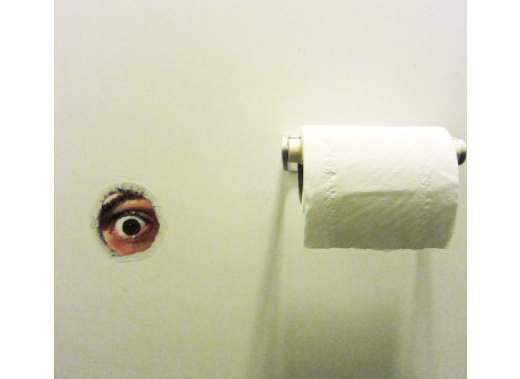When it comes to public, anonymous sex, glory holes have always been the Holy Grail for men. While some men may balk at the idea of sticking their dick into a hole in the wall and hoping for the best, others have no such reservations. Over the years, glory holes have been featured in comics, television shows and even commercials.
 But for all their pop culture prevalence glory holes are still mainly seen as something of a sexual urban legend. Glory holes have always been more commonly associated with gay men. Historically, glory holes have been a feature in bathroom stalls and arcades where men could engage in completely anonymous sex. Usually the assumption is that the person on the other side will provide oral sex, though anal sex and hand jobs are common as well. The key is that the act is completely anonymous and with no strings attached. That’s made glory hole sex popular and alluring to men for generations and across a number of different cultures.
But for all their pop culture prevalence glory holes are still mainly seen as something of a sexual urban legend. Glory holes have always been more commonly associated with gay men. Historically, glory holes have been a feature in bathroom stalls and arcades where men could engage in completely anonymous sex. Usually the assumption is that the person on the other side will provide oral sex, though anal sex and hand jobs are common as well. The key is that the act is completely anonymous and with no strings attached. That’s made glory hole sex popular and alluring to men for generations and across a number of different cultures.
The history of glory holes, like the history of many sexual practices, is somewhat murky. In the early 1700s, many gay men in London would frequent the detached bathrooms, called bog houses, of local inns and pubs. One such bog house, the Temple Bog House, had a hole deliberately drilled into one of the walls in order to facilitate anonymous sex making it the earliest documented glory hole. Considering homosexuality was punishable by death at the time, the need and desire for anonymous sex contributed to the rise and spreading popularity of glory holes throughout the area.
Over the years, glory holes grew in popularity and prevalence and became ingrained into the history of gay culture. Throughout the 1950s, 60s and 70s glory holes were a mainstay for gay men in search of ways to hook up and get off. They remained the perfect solution both for gay men in search of a good time and men who presented as straight in the “real world” but who also harbored homosexual feelings or simply a curious urge. Whatever the motivation, glory holes remained popular enough to attract the attention of gay, bisexual and curious men that they were featured in filers for clubs and even on underground gay travel pamphlets and, later, websites and message boards that catered to the gay male community.
The physical divide glory holes provided meant anonymous sex for the adventurous and a way for curious men to experiment with homosexuality without having to really commit. Many heterosexual men continue to frequent glory holes even though they are generally manned by gay men. In this regard, glory holes have acted as a kind of front line sexual therapy for men who feel conflicted about their sexuality. A man who identifies as straight but wonders about what it’s like to have sex with a man can use a glory hole to satisfy his curiosity without feeling as though he’s “gone gay”. Some say this makes it easier for men to explore and accept their sexuality, others say it only divides people further since it depersonalises sex. Either way, the glory hole phenomena grew in popularity throughout large cities and could be found in bathroom stalls, adult bookstores and sex clubs.
The AIDS epidemic in the 1980s prompted many men to rethink their attitude and approach when it came to public sex. Suddenly, receiving anal or oral sex from an anonymous stranger carried more of a risk than simply being picked up and possibly charged with indecent exposure, sodomy or any other charge often used to essentially persecute homosexuals. Glory holes fell out of favour as the disease forced the LGBT community – and gay men in particular – out of the shadows and into the spotlight demanding help in battling the disease, better understanding how to protect themselves and, ultimately, no longer having to engage in clandestine meetups in general.
The AIDS scare of the 80s may have dampened the popularity of glory holes, but since then they’ve resurfaced with a whole new modern twist. Today, glory holes are popular once again but not just with the gay male population. While they remain most popular with gay men, women have gotten in on the action thanks, in part, to the acceptance of glory holes into mainstream porn and adult sex play.
Today, there are still traditional glory holes that can be found in public restrooms but they’ve also been given a modern update. Many sex clubs feature glory holes with padding, making them easier to use, and featuring both men and women on the other side. Pornographic films featuring glory holes are now easier than ever to find and the idea has also made it into mainstream cable television. The popular Showtime docuseries Gigolos featured an enhanced version of the traditional glory hole in its 4th season. The episode featured a client who wanted her ultimate fantasy fulfilled which was centred  around the glory hole ideal – anonymous sex with multiple men. The gigolo in charge of delivering her fantasy recruited the help of his friends to create a box the client would enter and then holes for each of the male gigolos to use as glory holes. The creation, ultimately dubbed The Spurt Locker, sparked plenty of conversation on adult forums as well as a number of people offering up their advice on how people could build their own private and portable glory hole systems.
around the glory hole ideal – anonymous sex with multiple men. The gigolo in charge of delivering her fantasy recruited the help of his friends to create a box the client would enter and then holes for each of the male gigolos to use as glory holes. The creation, ultimately dubbed The Spurt Locker, sparked plenty of conversation on adult forums as well as a number of people offering up their advice on how people could build their own private and portable glory hole systems.
Although the history of glory holes remains somewhat sketchy, there’s no denying they’ve played a large role in the development of subversive sexuality. Once seen as the exclusive prevue of gay men, today glory holes are decidedly inclusive – that’s the whole attraction. Age, eye colour, body shape and even gender suddenly become meaningless thanks to the physical detachment a glory hole creates. Many experts claim it also creates a psychological barrier, making it an odd form of safe exploration for men with homosexual curiosity, but who are still unable to fully engage with others. The allure of anonymous partners has prompted heterosexual women to co-opt the idea and today glory holes are a ![]() mainstay of straight porn, a feature in some straight sex clubs and have inspired a whole new range of sex props. While glory holes aren’t exactly ubiquitous, they remain a popular feature and have great influenced both human sexuality and pop culture. Far from an urban legend, this phenomena not only highlights the pervasive human desire for anonymous sex, it also stands as an icon for just how far we’re willing to go – and the risks we’re willing to take – to get off.
mainstay of straight porn, a feature in some straight sex clubs and have inspired a whole new range of sex props. While glory holes aren’t exactly ubiquitous, they remain a popular feature and have great influenced both human sexuality and pop culture. Far from an urban legend, this phenomena not only highlights the pervasive human desire for anonymous sex, it also stands as an icon for just how far we’re willing to go – and the risks we’re willing to take – to get off.










